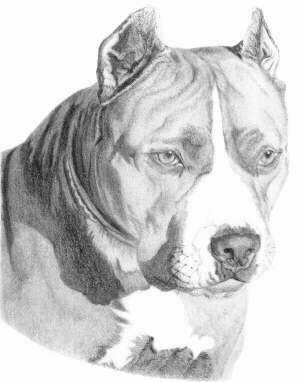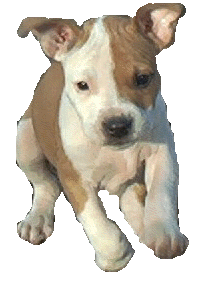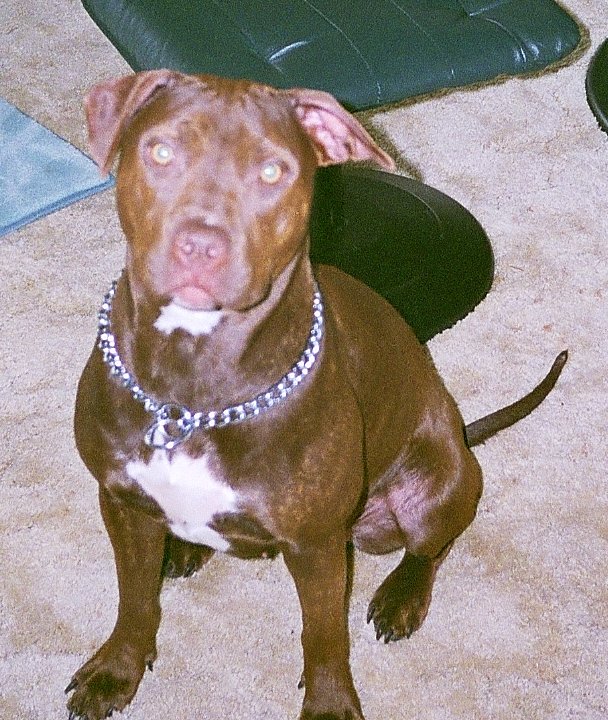|
|
|
The Truth About Pit Bulls

The history of the American Pit Bull Terrier is a contentious issue and is divided largely into two schools of research. In the first school we have sources of information as trusted as the authors of encyclopedias and other reference books, while in the second school we have theories based largely on the research of men like Richard F. Stratton and the recall of some old time dog men.
I personally find the findings of the first, and by far the more convincing, school to concurred with my own logic and opinion.
Here I will proceed to layout the history of the American Pit Bull Terrier as I understand it to be.
Variations of large Mastiff type dogs have been used in various blood sports since ancient times. Some variation of these dogs excelled at the popular sports of the times, including Bull baiting, and were dubbed Bull Dogs.
A certain group of these Bull Dogs were strongly breed in England, but sometime in the early 1800's dog men crossed the best Bull Dogs to the best terriers in the hope of achieving an even better fighter by adding the speed and agility of the rat-killing and badger-baiting terrier to the power of the Bull Dog. If I recall correctly one of the terrier breeds was the now extinct White English Terrier.
This is where the second school disagrees and maintains that today’s APBT is not the result of this cross but is rather the direct descendant of the original Bull Dog. This new dog was called amongst others the Bull-and-Terrier or Half-and-Half. Mainly he dogs breed in the coal mining Stafford shire county resulted in the modern day Stafford shire Bull Terrier.
So one can think of the British Stafford shire Terrier as being a direct descendant of the original Bull-and-Terrier, although it is still a capable and intelligent dog it diverts from the original due to that fact that it is now no longer breed as performance dog but almost exclusively as a show/conformation dog.
Other crosses were also made including crosses to the Dalmatian! This resulted in the modern day English Bull Terrier.
In 1835 England passed a Humane Act which made blood sports illegal. Since dogs could be secretly pitted against each other in much smaller areas than bull baiting rings the clandestine breeding of dogs for the pit continued strongly in England as well as Ireland.
An interesting point is to note that this breeding for fighting ability resulted in dogs that also needed great intelligence to survive.
America had its share of dog fighting too and as a result the Bull-and-Terrier made its way there too. Here these dogs were also used as catch dogs, hunting dogs and protectors of farm animals and of course a protector of people. They were then selectively breed to be larger than the Bull-and-Terrier dogs.
In 1898 The United Kennel Club (UKC) was founded and registered these fighting dogs originally as American Pit Bull Terriers and later as American (Pit) Bull Terriers, eleven years later the American Dog Breeders Association (ADBA) was founded and also accepted these dogs into its registry as Pit Bull Terriers. Later in 1935 the AKC was petitioned to also include these dogs into its registry and they decided on the name Stafford shire Terrier later changing it to American Stafford shire Terrier. The AKC was and is absolutely against the pitting of dogs and registered the dog by binding it to very specific physical conformational traits. The problem with this is that traits such as intelligence and gameness (courage, willingness, attitude) that can't be measured by some physical characteristic are thus merely disregarded.
An important point to note is that the AKC American Stafford shire Terrier and the ADBA Pit Bull Terrier/UKC American (Pit) Bull Terrier are now considered entirely separate breeds. The reason for this is that for the last 60 years or so the American Staffford shire Terrier has been breed largely to other AKC registered American Staffordshire Terriers. The point being that American Stafford shire Terriers are almost exclusively breed as a show/conformation dog whereas the Pit Bull is still strongly breed with performance criteria as the main goal.
We do however find conformation shows for true Pit Bulls too which also includes weightpulling (Pit Bulls own many of the entries in dog club record books), high jumping, and tests where the dog latches onto a piece of rope etc and hangs onto it while being suspended from a low height - the aim being to see which dog can hang on for the longest period of time. Pit Bulls have also started participating in Schutshund trials and other attack and obedience competitions.
Pit Bulls are now largely owned by loving families and are kept as house pets due to their remarkable qualities.


- Thunder Ridge Pits
- PitBull World
- Paba Pits